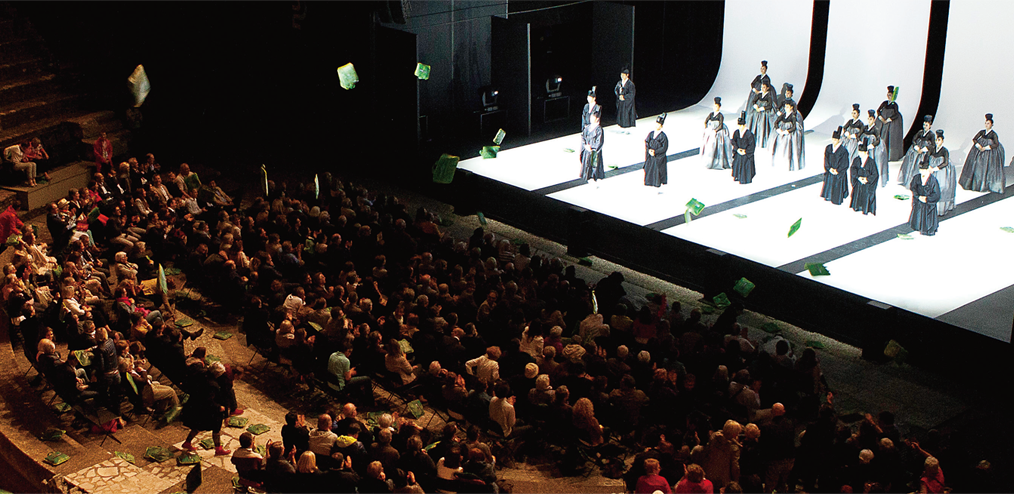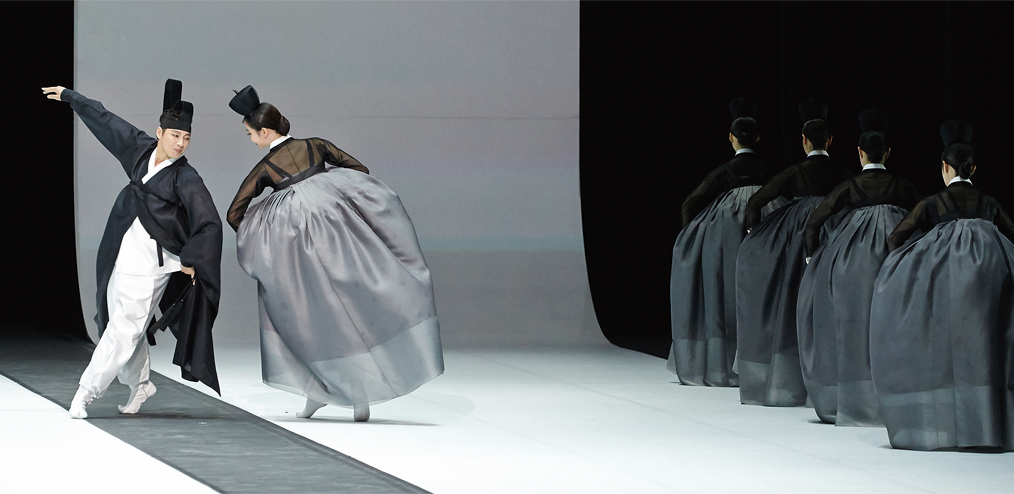An innovative attempt by the National Dance company of Korea, “vortex” was performed from
March 30 to April 1, 2017, at the National theater of Korea. It focused on the themes of nature and
humanity as well as tradition and modernity, breaking away from the troupe’s roots in traditional Korean dance.
an experimental work combining modern and traditional elements, “Vortex” by the
national Dance Company of Korea was a big sensation in the Korean dance scene.
the music ensemble Be-Being is seated on one side of the stage, their music artfully
complementing the performance dismantling and reassembling convention.
The National Dance Company of Korea’s creative experiments have thus far received mixed reviews.
“Vortex,” however, could serve as a meaningful reference point for how far the company with its roots
in traditional Korean dance can take its new artistic ventures.
“Vortex” is a clear departure from the choreographic style the National Dance Company of Korea
has pursued over the past decades. The dancers convey the “unpredictable motions of the beginning
of the universe” in an 80-minute performance of intense energy, leaving the audience in
deep awe. Finnish choreographer Tero Saarinen is the mastermind behind this bold undertaking. He
studied Peking opera and Japanese Butoh dance, both of which have become an important influence on
his work, as his debut piece in Korea has clearly illustrated.
Movements that Reject Convention
The motif of Saarinen’s choreography is the “early ages of humanity,” with primeval rituals highlighted
throughout the piece. At the same time, the movements aspiring to return to the beginnings are artfully
interwoven with the modernity of the “here and now.”
The performance begins with movements within stillness and stillness within movements. The adroit
bodily movements of the dancers expressing the subtle beauty of the reversal demonstrate well-honed
artistry. The unrefined, rough motions of some of the male dancers have a simple and unsophisticated
beauty. The movements of the group dance are agile and fervent, projecting a primal force.
The simple, lightweight costumes enveloping the dancers’ bodies, reminiscent of Greek tunics, allow
unrestricted movements. A distinct departure from the typical costume of traditional Korean dance —
full skirt and jacket, padded socks, and chignon — the thin, flowing garments are liberating. They bring
to mind American dancer Isadora Duncan, who rejected the rigid technique of classical ballet and pioneered
innovative dance techniques that earned her the title “the mother of modern dance.”
The music was played by Be-Being, a contemporary ensemble led by Jang Yeong-gyu. This talented
group is opening new horizons in theatrical dance music. Offering a contemporary take on traditional
Korean instruments, including the haegeum (two-ed fiddle), piri (bamboo oboe), and gayageum
(12-ed zither), the musicians delivered an outstanding performance that was at once tranquil,
exhilarating, and explosive, and pansori (traditional narrative song) singer Lee Seung-hee was absolutely
riveting. Blending modern and traditional elements, Be-Being’s light yet solemn music amplified the
ritualistic atmosphere arousing new sensibilities.
The stage design and lighting by Finnish set designer Mikki Kunttu were also noteworthy. He took the
unprecedented step of removing the curtain on the left side of the stage and placing the band there. One
drawback of this arrangement was that it made it difficult for the dancers to enter and exit the stage,
disrupting the flow of the performance. Based on the theme of rituality, the lighting was at times dreamlike,
at others jubilant; it clearly demonstrated why Mikki Kunttu is an artist of international repute.

The National Dance Company
of Korea performs
“The Scent of Ink,” choreographed
by Yoon Seong-joo
and premiered in 2013, at
the Nights of Fourvière (Les
Nuits de Fourvière) festival
in Lyon, France in June 2016.
The company had also been
invited to present the work at
the Hong Kong Arts Festival
earlier in the year.
Experimental Endeavors
“Vortex” premiered in 2014. The National Dance Company of Korea, known for its adherence to tradition,
embarked on a brave experiment in 2013. Deviating from the framework of conventional theater
dance, it sought to create a new performance aesthetic through “image dance,” or abstract concepts.
The experiment unfolded in two directions. The first was collaboration with a choreographer working in
contemporary dance, which resulted in “Altar,” choreographed by Ahn Sung-soo.
The second was the first-ever collaboration with a foreign choreographer in the company’s 55-year
history, and Tero Saarinen was declared its initial choice. Curiosity over his appointment was further
augmented when it became known that world-renowned contemporary dancer and choreographer
Carolyn Carlson had announced that Saarinen would reinterpret her legendary solo piece “Blue Lady.”
What would a choreographer with an unrivaled reputation in Europe present to Korean audiences? The
dance community awaited the outcome of this unprecedented endeavor with a mixture of anticipation
and apprehension.

The National Dance Company
of Korea performs
“The Scent of Ink,” choreographed
by Yoon Seong-joo
and premiered in 2013, at
the Nights of Fourvière (Les
Nuits de Fourvière) festival
in Lyon, France in June 2016.
The company had also been
invited to present the work at
the Hong Kong Arts Festival
earlier in the year.
The premiere of “Vortex” was a success. Many talked about its exquisite stage art in which the disparate
and unfamiliar intersected amid the mélange and clash of tradition and modernity, and East and
West.
Compared to the premiere, this year’s performance displayed a higher level of artistry. To begin with,
the dancers’ movements were far more refined. Transcending genres, they achieved an intimacy stemming
from the internalization of movements. Lead dancer Kim Mi-ae stood out, showing her ability to
deftly render all types of movements, ranging from traditional Korean dance to modern dance. The artistry
and spirit of Song Ji-yeong, Hwang Yo-cheon, and Lee Seok-jun left a deep impression on the audience;
they are clearly on the road to becoming the main faces of the troupe. The collaboration among
artists beyond national boundaries in music, lighting, and costume heightened the aesthetic value of the
piece, resulting in its maturing artistry.

The costume by Erika Turunen
hides a microphone in its folds
to amplify the sound of the wind
caused by the dancer’s movements,
which blended well with
the music.
The stage set by Mikki Kunttu
emphasizes the contrast of the
yellow floor and the simple black
background.
Possibilities and Limitations
The new endeavors have opened doors for the dance company overseas. In 2015, “Vortex” was invited
to the Cannes Dance Festival, and the following year, “The Scent of Ink,” choreographed by Yoon Seongjoo
and acclaimed for its modern reinterpretation of traditional Korean dance and costume, was invited
to the Hong Kong Arts Festival. “Shigane Nai” (“The Age of Time”), choreographed by Jose Montalvo,
premiered in March 2016 at the National Theater of Korea and was staged again at the Théâtre National
de Chaillot in Paris a mere three months later.
Whereas the company’s overseas performances in the past were largely part of its role as Korea’s
cultural ambassador, its recent performances abroad are a sign of the increasing international recognition
of its status as a dance company.
Through collaboration with a preeminent foreign choreographer, “Vortex” clearly demonstrated how
tradition can be modernized. Being non-Korean, the choreographer was able to freely cross the boundaries
from traditional to modern to creative dance, adopting the flow of Korean dance solely as a source
of creative inspiration. However, by freely incorporating any type of dance movement, the distinctive style
of Korean dance was completely dismantled, so that at times it seemed as though only the movement
itself remained.
The National Dance Company of Korea’s creative experiments have thus far received mixed reviews.
“Vortex,” however, could serve as a meaningful reference point for how far the company with its roots in
traditional Korean dance can take its new artistic ventures.